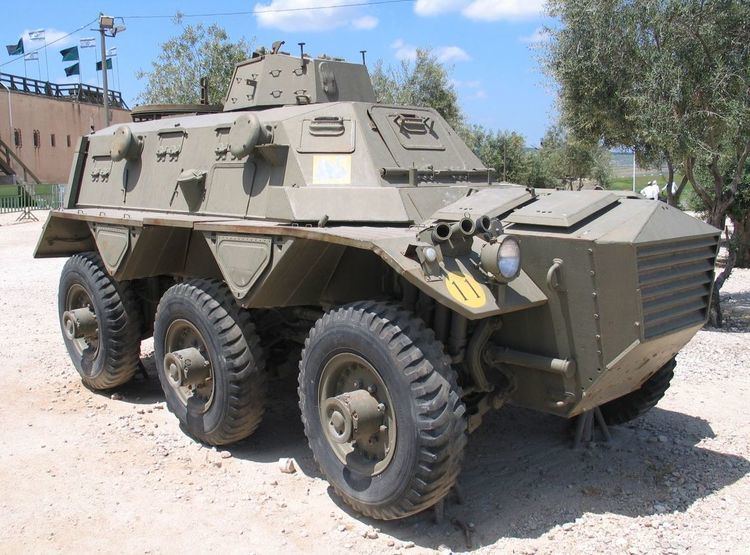Length 4.8 m Height 2.46 m | Weight 11 t Width 2.54 m | |
 | ||
The FV603 Saracen is a six-wheeled armoured personnel carrier built by Alvis and used by the British Army. It became a recognisable vehicle as a result of its part in the policing of Northern Ireland.
Contents
History
The FV603 Saracen was the armoured personnel carrier of Alvis' FV600 series. Besides the driver and commander, a squad of eight soldiers plus a troop commander could be carried. Most models carried a small turret on the roof, carrying a Browning .30 machine gun. A .303 Bren gun could be mounted on an anti-aircraft ring-mount accessed through a roof hatch and there were ports on the sides through which troops could fire. Although removed from active service, it saw extensive use into the 1980s in Northern Ireland and was a familiar sight, nicknamed 'sixers', during "The Troubles". At times, they appeared on the streets of Hull, a less-hostile atmosphere for driver training in a city of similar appearance to Belfast, and only a few miles from the Army School of Mechanical Transport.
As a member of the FV 600 series, it shared a similar chassis with the FV601 Saladin armoured car, the Salamander airfield crash truck and the Stalwart high mobility load carrier. The chassis, suspension and H-drive drivetrain remained similar, but the engine, transmission and braking systems varied significantly.
The Saracen was in turn used as an armoured personnel carrier, armoured command vehicle and ambulance. The FV 603 model saw many variants in detail, including radio or command fitments and specialist equipment for artillery or signals use.
The Saracen series also includes:
Saracen was produced before Saladin because of the urgent need for a personnel carrier to serve in the Malayan Emergency, entering production in 1952.
The Saracen was produced both with and without turrets fitted. They are popular with collectors due to their prices being as low as $20,000 in Australia and $11,000 in the Czech Republic.
Combat history
Military operators
Civil operators
Variants
Saracens were initially equipped with an L3A4 (0.30-inch Browning) machine gun in the turret, and a Bren light machine gun for the gun-ring at the rear of the vehicle. Later Marks carried the LMG, and L37 GPMG.
Mk 1: Early version with a small 3-door turret and turret weapon ports.Mk 2: Modified Mark 1 with later two-door turret. The rear turret door folds down and can act as a seat for the commander.Mk 3: Reverse-flow cooling for use in hot climates.Mk 4: Prototype only.Mk 5: Mark 1 or Mark 2 vehicles modified with extra armour specifically for use in Northern Ireland.Mk 6: Mark 3 modified with extra armour as for the Mk 5 for use in Northern Ireland.Concept 3 New Generation Armoured Car: Mk 3 suspension and drive train with chassis redesigned by the South African Defence Force to accept a 77mm HV tank gun. Prototype only.In popular culture
A Saracen masquerades as a German armoured car in the 1964 film 633 Squadron, which was set during World War II, a decade before the Saracen was first built.
In the 1967 episode "Mission Highly Improbable" of the TV series The Avengers (the penultimate episode with Diana Rigg in the female leading role), the villainous Dr Matthew Chivers (played by Francis Matthews) is trying to smuggle a Saracen FV 603 out of a British Army testing area by shrinking it to toy size with the help of a machine invented by his boss Professor Rushton (played by Noel Howlett).
In the Tom Sharpe novel Riotous Assembly, a Saracen is destroyed with an elephant gun by Constable Els of the South African Police.
In the 1992 film The Crying Game, a character who was kidnapped by the IRA was accidentally run over and killed by a British Saracen.
In the 1983 debut album Script for a Jester's Tear, by British progressive rock group Marillion, the Saracen was referred to in the final song: "...crawling behind a Saracen's hull from the safety of his living room chair..." The lyrics of Forgotten Sons describe the conflict in Northern Ireland and the discrepancy between what was really happening and the perception of the conflict by the British public.
Saracens were used almost unchanged in the 1995 film of Judge Dredd as carriers for prisoners and personnel carriers for Judges. 101 FCs were used as the basis for taxis, fitted with a prop bodyshell.
During the 2009 G-20 demonstrations in London, members of the Space Hijackers protest group drove their Saracen into the City of London and parked it outside the Royal Bank of Scotland in Bishopsgate. The Saracen, which had been painted bright blue with black and white chequered stripes, was equipped with CCTV and marked "RIOT" (but not "police"). The group were reportedly there to protect the RBS building from "bad" demonstrators, although the police declined their assistance. Instead, the vehicle was searched and police questioned the protestors, who were dressed in plain blue overalls and helmets. The vehicle's eleven occupants were arrested for impersonating police officers and for traffic offences, and were later charged with impersonating police officers, although the case was dropped before coming to court.
A community protest, against the sale of heritage-listed Fort Largs by the state government of South Australia, took place on 25 October 2014. The protest, organised by the National Trust of SA, featured an Alvis Saracen and other vintage military vehicles.
